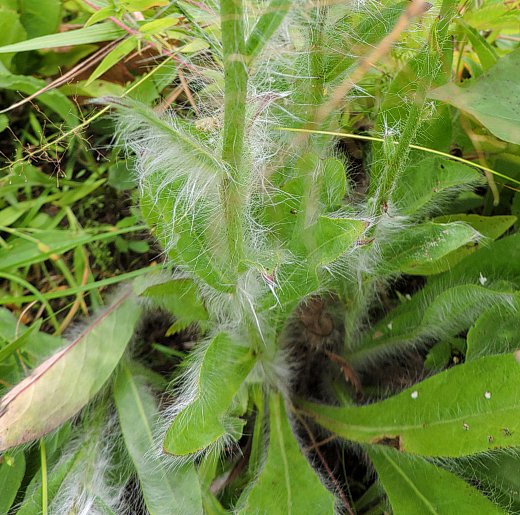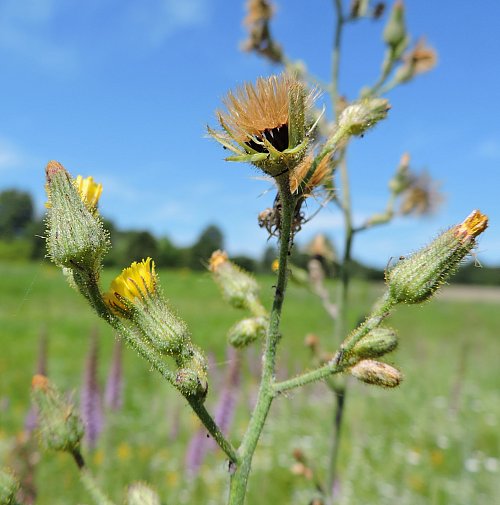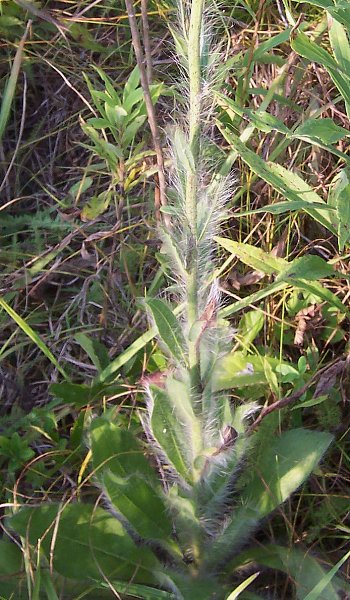
The flowerheads are ½–1" across when they are fully open, consisting of 30-80 fertile ray florets and no disk florets. The spreading petaloid rays of these florets are yellow and linear in shape; their tips are truncate and 5-toothed. The base of the flowerhead is cylindrical-campanulate (cylindrically bell-shaped) or cylindrical-urceolate (cylindrically urn-shaped); it is surrounded by several phyllaries (floral bracts) in a single series. These phyllaries are linear-lanceolate in shape, appressed, pale green, and glandular-hairy. Some of the glandular hairs on the phyllaries have black bases. There are also secondary floral bracts that are much smaller in size; they are located at the base of the flowerhead. The blooming period occurs from mid-summer to late summer, lasting about 1 month for a colony of plants. Afterwards, the florets are replaced by achenes with tufts of tawny hair at their apices; they are distributed by the wind. The achenes are 3-4 mm. long, dark-colored, and fusiform (spindle-shaped); there are no thread-like beaks connecting the tufts of hair to the achenes. The root system consists of a caudex or short crown with fibrous roots.

Cultivation: The preference is full sun, mesic to dry conditions, and soil containing loam, clay-loam, sand, or rocky material.
Range & Habitat: Long-bearded Hawkweed is a native plant that has been found in most areas of Illinois, although it is now widely scattered and uncommon (see Distribution Map). Populations of this plant have declined with the destruction of prairie habitat. Habitats include black soil prairies, clay prairies, sand prairies, prairie remnants along railroads, typical savannas and sandy savannas, upland rocky woodlands, and disturbed areas along railroads. Long-bearded Hawkweed occurs primarily in high quality natural areas.

Faunal Associations: Very little is known about the floral-faunal relationships for Long-bearded Hawkweed. Gangwere (1961) reported that Spharagemon bolli (Boll's Grasshopper) feeds on the dry leaves of this plant. The flowerheads of hawkweeds (Hieracium spp.) are cross-pollinated primarily by little carpenter bees (Ceratina spp.), Halictid bees (including green metallic bees), and other bees. Some aphids feed on the sap of these plants, including Nasonovia ribisnigri (Currant-Lettuce Aphid) and Uroleucon sonchi (Sow Thistle Aphid); see Blackman & Eastop (2013). The Ruffed Grouse and Wild Turkey feed on the basal leaves and seeds of hawkweeds, while their foliage is sometimes browsed by the White-tailed Deer and Cottontail Rabbit (Martin et al., 1951/1961). However, Georgia (1913) states that cattle and other domesticated livestock usually avoid the hairy bitter foliage of these plants.

Photographic Location: A prairie in Fayette County, Illinois. The photographs were taken by Keith & Patty Horn (Copyright © 2015).
Comments: The native Long-bearded Hawkweed can be distinguished from other hawkweeds (Hieracium spp.) by the exceptionally long hairs (1/3–1" in length) of its basal leaves, lower alternate leaves, and lower flowering stalk. Other hawkweeds in Illinois have hairs that are less than 1/3" long. In addition to having shorter hairs on its foliage, a similar native species, Hieracium gronovius (Gronovius' Hawkweed), has slightly smaller flowerheads with fewer ray florets (20-40). Another common name of Hieracium longipilum is Long-haired Hawkweed.